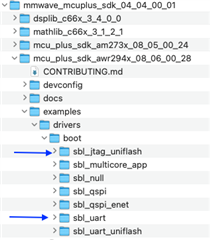⇐ Back to Main FAQ Thread : [FAQ] PLEASE READ : mmWave Forum Guidelines and FAQ Thread
This Thread addresses FAQ in context of mmWave SDK (SW) , Features add on or tweaks to Demo codes (or Labs)
Q1. How to create a new mmwave sensor project from scratch [Project0]?
Answer: Please refer this thread- https://e2e.ti.com/support/tools/ccs/f/81/t/836333
Q2. How to find root-cause if a device goes into fault at DSS/BSS end OR how to find if a device is in fault/bad state?
How to decode the error value mmWave library throws at the application level?
Answer: mmw demo from mmWave SDK checks application status or return values of a function to find out device health and goes into ASSERT if something wrong. Error at DSS is communicated to MSS which says the source code line no. for user to find out root cause.
If BSS goes into some error state or fault then it sends CPU/ESM/Analog Fault asynchronous event [RL_RF_AE_CPUFAULT_SB, RL_RF_AE_ESMFAULT_SB, RL_RF_AE_ANALOG_FAULT_SB] to MSS, MSS application needs to handle these fault. Most of the time recovery from these faults is to reset the device. It can be done by an external processor (notify over nError-out), internal Watchdog, External Watchdog.
At most of the error points, mmw demo sets errCode from the function (like mmwave library) which contains the cause of error.
[bit 31:16] - mmWave Error : MMWAVE_EINVAL to MMWAVE_EINVALIDCALMONUNIT (mmwave.h)
[bit 15:2] - sub system Error : It can be from DSS or BSS, For BSS error codes are defined in mmwavelink.h 'RL_RET_CODE_***'
[bit 1:0] - error level : MMWave_ErrorLevel
Q3. How to send custom user data or intermediate FFT processing data over LVDS?
Answer: Refer related threads-
https://e2e.ti.com/support/sensors/f/1023/p/758435/2803488
https://e2e.ti.com/support/sensors/f/1023/t/759979
Q4. How much time does SBL take to boot up and time to switch to the application?
Answer: Boot up time of SBL depends on the size of SBL image which PBL (primary bootloader) takes to copy content from sFlash to RAM. Default SBL in the SDK takes around 35msec to bootup (measured from nRST: device reset) and SBL to application (mmw demo from SDK 2.1) boot takes around 65mSec. Again these two times vary based on image size.
Here is similar e2e thread https://e2e.ti.com/support/sensors/f/1023/p/767876/2838860#2838860
Q5. What is the format of the data mmw demo sends out over UART?
Format of object data out from application may differ based on SDK version and for different application. These links will explain the basic format of that, most of TI-Rex application provides output data format in their user/developer user guide document.
https://e2e.ti.com/support/sensors/f/1023/t/753460
Even after this you don't find exact output format of any of mmwave sensor application, then you need to dive into source code. DSS generates the object data packet, copies to HSRAM and sends to MSS which further sends it over UART/CAN interface. Look for function having string 'sendProcessOutputToMSS' or 'sendResult' in dss_main.c (most of the application uses similar function name), now you can backtrace to find the packet format.
Q6. Implement the watchdog feature with mmw demo application
Answer: At this thread, code snippet is provided to implement the watchdog feature to mmw demo-
https://e2e.ti.com/support/tools/ccs/f/81/p/835932/3091964#3091964
Q7. How to get input from CCS console?
Answer: Many of times while application development, we need to take input from CCS GUI only. Refer these threads to do that:
https://e2e.ti.com/support/sensors/f/1023/p/838177/3099822#3099822
https://e2e.ti.com/support/microcontrollers/msp430/f/166/t/439318?Scanf-in-CCS-for-MSP430
Q8. How to add sFlash feature in the mmw demo or any other mmwave application?
Please refer this application note- http://www.ti.com/lit/an/swra583/swra583.pdf
Q9. How do I reset the device from the application itself?
You can use the internal watchdog feature to reset the device, refer this thread to implement the watchdog in the application.
Other option by directly writing a register to force a Warm Reset to the device.
|
|
|---|
⇐ Back to Main FAQ Thread : [FAQ] PLEASE READ : mmWave Forum Guidelines and FAQ Thread






